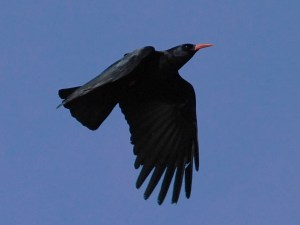John Tredinnick-Rowe and Jeremy Anbleyth-Evans, ‘The worth of a chough: contingent valuation of P Pyrrhocorax in Cornwall and the connections to Cornish identity’, Campus 25.30 (2020), pp.209-36.
Once a common sight on our coasts, the red-billed chough disappeared from Cornwall in the 1940s. It had fallen victim to changing farming practices that were destroying its cliff-top habitats. However, in 2001 the chough, which had survived in Brittany and Wales, made a fortuitous re-appearance, one that was then aided by a RSPB (Royal Society for the Protection of Birds) conservation project.
The presence of choughs around the Cornish coastline is not something that mainstream economics would value, as natural resources have no direct monetary value. Nevertheless, DEFRA (the Department for Environment, Food and Rural Affairs) states that ‘natural capital’ should now be considered in decision-making, at least in theory. The problem is how to assign value to it. In this article the authors set out to do exactly that – to assign a monetary value to the preservation of the chough.
They do this through what is called a contingent valuation method, which elicits the value placed on a resource by investigating consumer preferences. In short, what are individuals willing to pay to protect the Cornish chough? The answer is a very precise £23.60.
Or at least that’s the average amount the 114 people who responded to their on-site and online survey would pay. Women would pay up to a third more than men as would those who had prior knowledge that choughs nest on the Lizard. It doesn’t come as a great surprise either to find that people with higher incomes were willing to pay more. The better-off were predominantly aged from 50 to 69. Strangely, given the connection in the title to identity, the authors did not include ethnicity among their variables.
Sophisticated statistical regression techniques did not make this exercise in neo-classical economics any more credible. The authors themselves admit that such an approach is too simplistic as attitudes to the conservation of the chough are not shaped by its use value (a value realised only in consumption). Instead, they concur with what ought to be common sense – the willingness of people to pay for environmental conservation relates as much if not much more to bequest values (satisfaction from preserving an environment for future generations).
In the case of the chough bequest values are not just environmental but also cultural. The bird has a special relationship with Cornwall, something recognised by Cornwall County Council in 1939 when it placed a chough prominently on its coat of arms (just as it was disappearing from Cornwall along with the traditional occupations of mining and fishing also depicted). It’s also associated with the Arthurian legend. Known more widely as the ‘Cornish’ chough, in Welsh it’s called brân gernyw or Cornish crow. However, the good news is that, even though absent for a couple of generations, this year a record number of 112 chough chicks fledged in Cornwall. The Cornish chough seems to be among the minority able to buck our determined drive to achieve mass species extinction.
Given the connection between the red-billed chough and Cornish identity we might ask what people are prepared to pay to ensure the survival of the Cornish nation. Now that would be truly ground-breaking research although the answer may not be so welcome.
